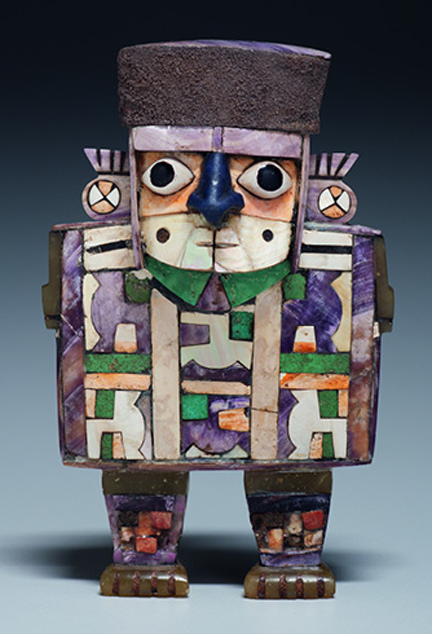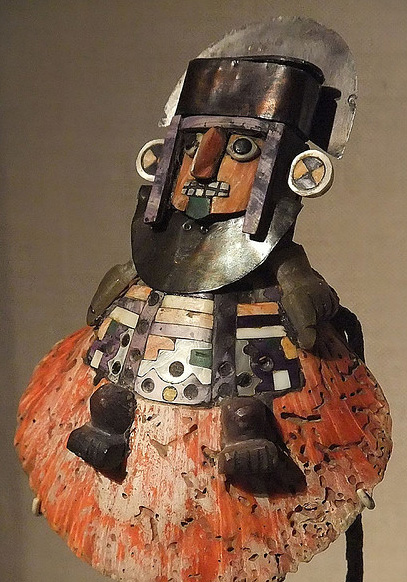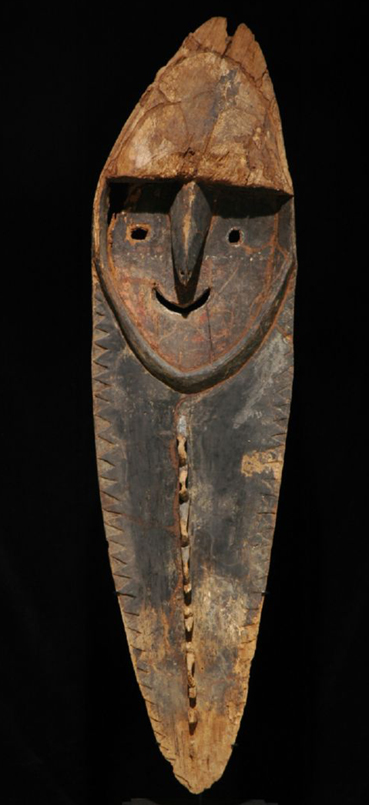It looks like you're using an Ad Blocker.
Please white-list or disable AboveTopSecret.com in your ad-blocking tool.
Thank you.
Some features of ATS will be disabled while you continue to use an ad-blocker.
share:
reply to post by Kantzveldt
The paper I read mentioned the chachapoya interms of then having some rare genetic sequence that they share with some other population not in the Andean region. I'm going keep looking for it.
As to the dentition, yes they do share shoveling on the incisors, a trait that is part of the sinodont dental complex, that most native Americans share.
The discussion of dentition muddies up the waters of human dispersal, because it shows a direction of movements contrary to the accepted .
A few years ago when I first learned that modern humans can be classified into types based on dentition, I was fascinated. There are certain traits of teeth shared by native Americans and north east asians called sinodonty, in contrast there is sundadonty that is found among the people of south east Asia and oceana.
It is the extreme shoveling in north east asians that gives us that iconic stereotype of the buck toothed Asian.
Interesting thing is that much of the sinodont complex is also an archaic set of traits shared with Asian homo erectus.
Here's an interesting discussion of the east-west decrease in shoveling and its implications.
anthropogenesis.kinshipstudies.org...
The paper I read mentioned the chachapoya interms of then having some rare genetic sequence that they share with some other population not in the Andean region. I'm going keep looking for it.
As to the dentition, yes they do share shoveling on the incisors, a trait that is part of the sinodont dental complex, that most native Americans share.
The discussion of dentition muddies up the waters of human dispersal, because it shows a direction of movements contrary to the accepted .
A few years ago when I first learned that modern humans can be classified into types based on dentition, I was fascinated. There are certain traits of teeth shared by native Americans and north east asians called sinodonty, in contrast there is sundadonty that is found among the people of south east Asia and oceana.
It is the extreme shoveling in north east asians that gives us that iconic stereotype of the buck toothed Asian.
Interesting thing is that much of the sinodont complex is also an archaic set of traits shared with Asian homo erectus.
Here's an interesting discussion of the east-west decrease in shoveling and its implications.
anthropogenesis.kinshipstudies.org...
Odontology is a subdiscipline of physical anthropology with a special swagger. With a strong genetic basis, functional independence of traits, their evolutionary stability, clear geographic patterning and easy comparability of ancient and modern samples, odontology can give evolutionary craniology and even population genetics a run for their money. I remember in 2003, at the Memorial Joseph Greenberg Conference in Stanford University, Christie Turner, the patriarch of American evolutionary odontology, in a lounge discussion, prided on the stability of dental traits compared to “Cavalli’s neutral genes,” which in his opinion spread around and mixed-and-matched in the last 20,000 years. Many odontologists believe that dental patterns reflect ancient population processes better than evolutionary craniology.
reply to post by Kantzveldt
Thank you for the response! This subject has a firm grip on me; I will definitely be looking into it; like my subscription says; there is a connection!
Thank you for the response! This subject has a firm grip on me; I will definitely be looking into it; like my subscription says; there is a connection!
reply to post by punkinworks10
I think it could take some time before the behavioral differences are explained in conjunction with the outward physical, the rare genetic sequences you mention sound interesting, and the dentistry is good indication that this was an Andean group that underwent changes from the norm.
A form of 'intervention' having taken place is my working hypothesis, an intervention that in the long term failed due to the circumstances of the Inca Empire and epidemics of the Post colonial period, but could have been an attempt to create a new form of society in the South Americas with a more progressive mentality and independence of thought, their culture was ideally situated for such a venture...a good story if nothing else.
reply to post by Trueman
Yes i noted a few mentions when i did a prior search, there were a few articles on them in 2008 which were briefly discussed, but i don't think their greater potential importance has yet been realised.
reply to post by EL1A5
We should always strive to be that connection....
I think it could take some time before the behavioral differences are explained in conjunction with the outward physical, the rare genetic sequences you mention sound interesting, and the dentistry is good indication that this was an Andean group that underwent changes from the norm.
A form of 'intervention' having taken place is my working hypothesis, an intervention that in the long term failed due to the circumstances of the Inca Empire and epidemics of the Post colonial period, but could have been an attempt to create a new form of society in the South Americas with a more progressive mentality and independence of thought, their culture was ideally situated for such a venture...a good story if nothing else.
reply to post by Trueman
Yes i noted a few mentions when i did a prior search, there were a few articles on them in 2008 which were briefly discussed, but i don't think their greater potential importance has yet been realised.
reply to post by EL1A5
We should always strive to be that connection....
edit on 22-1-2013 by Kantzveldt because: (no reason given)
Ahh I watched this program on the ancient south american cultures and these guys were on it was amazing, I prefer reading on here than the program
though!
Fantastic!
Fantastic!
Wow, one of the most informative posts I've seen in a while. Very well written, S&F
Can't wait to see the documentary!
Can't wait to see the documentary!
One thing is appearent, most people equate caucasoid with blonde hair, that is most incorrect.
Caucasoid skeletal morphology has nothing to do with hair color, in fact most caucasians, DO NOT HAVE BLONDE HAIR. Also people equate caucasians with Europeans, that is not the case at all. Caucasoid is a very distinct type of skeletal and dental morphology and has nothing to do with hair and or skin color.
Blonde hair is rare, even in European populations, and can be traced to a small ,very recent Eurasian imigrants into northern Europe, 3-5k years ago.
Red hair has been linked to Homo Heidlbergensis and neanderthals, it predates modern humans by several hundred thousand years.
It's my opinion that blonde and red hair in modern humans can be traced to an indiginous new world population that has been replaced by various waves of people from northeast Asia, whom just happen to be their descendants.
It is likely that "white skin" evolved in a central Eurasian population in response to diminished levels of sun light after the Toba eruption. This is an evolutionary adaptation to make more vitamin D.
Or my own theory is that an already lighter skinned people spent several generations in a low light area, such as an area that perpetually shrouded in dense fog, such as the central valley of California.
During the last ice age, the waterlogged san Joaquin valley would have been one of the foggiest places on earth.
Today here, with a wet winter the fog sets in and there have been times where you could not see the sun from the middle of November to the first days of February, literally two months where the best you get a dull glowing orb through the mists.
Even the local native Americans' mythology reflects the lack of sunlight in tales about coyote stealing the sun from or for the valley or mountain people
Caucasoid skeletal morphology has nothing to do with hair color, in fact most caucasians, DO NOT HAVE BLONDE HAIR. Also people equate caucasians with Europeans, that is not the case at all. Caucasoid is a very distinct type of skeletal and dental morphology and has nothing to do with hair and or skin color.
Blonde hair is rare, even in European populations, and can be traced to a small ,very recent Eurasian imigrants into northern Europe, 3-5k years ago.
Red hair has been linked to Homo Heidlbergensis and neanderthals, it predates modern humans by several hundred thousand years.
It's my opinion that blonde and red hair in modern humans can be traced to an indiginous new world population that has been replaced by various waves of people from northeast Asia, whom just happen to be their descendants.
It is likely that "white skin" evolved in a central Eurasian population in response to diminished levels of sun light after the Toba eruption. This is an evolutionary adaptation to make more vitamin D.
Or my own theory is that an already lighter skinned people spent several generations in a low light area, such as an area that perpetually shrouded in dense fog, such as the central valley of California.
During the last ice age, the waterlogged san Joaquin valley would have been one of the foggiest places on earth.
Today here, with a wet winter the fog sets in and there have been times where you could not see the sun from the middle of November to the first days of February, literally two months where the best you get a dull glowing orb through the mists.
Even the local native Americans' mythology reflects the lack of sunlight in tales about coyote stealing the sun from or for the valley or mountain people
edit on 22-1-2013 by punkinworks10 because: (no reason given)
Originally posted by punkinworks10
Even the local native Americans' mythology reflects the lack of sunlight in tales about coyote stealing the sun from or for the valley or mountain peopleedit on 22-1-2013 by punkinworks10 because: (no reason given)
I find it interesting that local native Americans believe a coyote steals the sun when it gets blocked out for too long. The Norse also have a legend about a sun stealing canine. This happens on the day of Ragnarok. The canine is a wolf in their mythology.
In stanza 46, Odin asks what sun will come into the sky after Fenrir (the wolf) has consumed the sun that exists. Vafþrúðnir responds that Sól will bear a daughter before Fenrir assails her, and that after Ragnarök this daughter will continue her mother's path.
en.wikipedia.org...
Both cultures may have had a common ancestor of which we’re trying to figure out in this thread.
Originally posted by lostinspace
Originally posted by punkinworks10
Even the local native Americans' mythology reflects the lack of sunlight in tales about coyote stealing the sun from or for the valley or mountain peopleedit on 22-1-2013 by punkinworks10 because: (no reason given)
I find it interesting that local native Americans believe a coyote steals the sun when it gets blocked out for too long. The Norse also have a legend about a sun stealing canine. This happens on the day of Ragnarok. The canine is a wolf in their mythology.
In stanza 46, Odin asks what sun will come into the sky after Fenrir (the wolf) has consumed the sun that exists. Vafþrúðnir responds that Sól will bear a daughter before Fenrir assails her, and that after Ragnarök this daughter will continue her mother's path.
en.wikipedia.org...
Both cultures may have had a common ancestor of which we’re trying to figure out in this thread.
the common ancestor of both is the fertile human mind.
why assume there is more to it than people making up a fanciful story? we know people do that, we have never found any signs of links between the two that can't be put down to being human.
An important consideration for the ancestral spirit figures and in particular the sarcophogi is that in their positions perched high on the cliffs
they are thought to be considered as overlooking nearby lakes, that of course takes us right back to Puma Punku and a cult that would have been
associated with lake Titicaca.
These are Wari figurines from that region, depicting the type of Deity we are concerned with for Puma Punku and Tiwanaku, the Chachapoya ancestor type.


Indulging in a little world wide comparative mythology we find examples such as this below from Nigeria;
n Benin the number three is associated with otherworldly powers. U-shaped waist pendants depicting the oba supported by two attendants were worn in sets of three by the oba and certain high-ranking officials. The abundant coral regalia worn by the oba, at center, identify him with Olokun, the god of the waters. The supernaturally charged stone bead (ivie egbo), worn at his chest, signifies his legitimacy

Or from Papau New Guinea we find,
Mindja, one of three types of carvings are recognizable by their large size, prominent nose, and rows of upturned spikes or spears that represent snakes. Mindja carvings are said to represent water spirits living in the lakes that are sometimes seen just under the surface of the water.

Of course when it comes to figures of this type overlooking waters then the Moai of Easter island are going to come in first place.
The creation myths from the Tiwanaku region indicate first creation from the waters of Lake Titicaca, with those waters being a metaphor for the 'cosmic waters'.
Thanks for the appreciation and interest with regards to replies...
These are Wari figurines from that region, depicting the type of Deity we are concerned with for Puma Punku and Tiwanaku, the Chachapoya ancestor type.


Indulging in a little world wide comparative mythology we find examples such as this below from Nigeria;
n Benin the number three is associated with otherworldly powers. U-shaped waist pendants depicting the oba supported by two attendants were worn in sets of three by the oba and certain high-ranking officials. The abundant coral regalia worn by the oba, at center, identify him with Olokun, the god of the waters. The supernaturally charged stone bead (ivie egbo), worn at his chest, signifies his legitimacy

Or from Papau New Guinea we find,
Mindja, one of three types of carvings are recognizable by their large size, prominent nose, and rows of upturned spikes or spears that represent snakes. Mindja carvings are said to represent water spirits living in the lakes that are sometimes seen just under the surface of the water.

Of course when it comes to figures of this type overlooking waters then the Moai of Easter island are going to come in first place.
The creation myths from the Tiwanaku region indicate first creation from the waters of Lake Titicaca, with those waters being a metaphor for the 'cosmic waters'.
Thanks for the appreciation and interest with regards to replies...
edit on 23-1-2013 by Kantzveldt because: (no reason given)
i wonder if DNA studies have been conducted on these people or their bodies and or closest ancestors, to see who they are closest related to among
modern ancestors.. they might find a remote relation!
a reply to: Kantzveldt
Thank you not much to say. But I am very impressed with the rock carvings..
Star and flag and thank you for the thread.
Thank you not much to say. But I am very impressed with the rock carvings..
Star and flag and thank you for the thread.
new topics
-
Denmark's Notre-Dame moment - 17th Century Borsen goes up in Flames
Mainstream News: 6 minutes ago -
We need less laws in the UK not more
General Chit Chat: 2 hours ago -
The Baloney aka BS Detection Kit
Social Issues and Civil Unrest: 7 hours ago -
Suspected Iranian agent working for Pentagon while U.S. coordinated defense of Israel
US Political Madness: 8 hours ago -
How does my computer know
Education and Media: 10 hours ago
top topics
-
Suspected Iranian agent working for Pentagon while U.S. coordinated defense of Israel
US Political Madness: 8 hours ago, 14 flags -
USO 10 miles west of caladesi island, Clearwater beach Florida
Aliens and UFOs: 15 hours ago, 9 flags -
The Baloney aka BS Detection Kit
Social Issues and Civil Unrest: 7 hours ago, 6 flags -
We need less laws in the UK not more
General Chit Chat: 2 hours ago, 4 flags -
How does my computer know
Education and Media: 10 hours ago, 3 flags -
Denmark's Notre-Dame moment - 17th Century Borsen goes up in Flames
Mainstream News: 6 minutes ago, 1 flags
active topics
-
We Captured a Honey Bee Swarm Today (Video)
Fragile Earth • 21 • : TheInvisibleRedneck -
The Baloney aka BS Detection Kit
Social Issues and Civil Unrest • 9 • : YourFaceAgain -
Suspected Iranian agent working for Pentagon while U.S. coordinated defense of Israel
US Political Madness • 20 • : xuenchen -
Denmark's Notre-Dame moment - 17th Century Borsen goes up in Flames
Mainstream News • 0 • : gortex -
Abortions in first 12 weeks should be legalised in Germany, commission says
Medical Issues & Conspiracies • 15 • : Sookiechacha -
Nakedeye Mother of Dragons Comet Is Here!
Space Exploration • 4 • : Astrocometus -
Terrifying Encounters With The Black Eyed Kids
Paranormal Studies • 37 • : Consvoli -
Fossils in Greece Suggest Human Ancestors Evolved in Europe, Not Africa
Origins and Creationism • 49 • : Consvoli -
The Truth About Jesus
Conspiracies in Religions • 266 • : All Seeing Eye -
We need less laws in the UK not more
General Chit Chat • 4 • : charlest2
